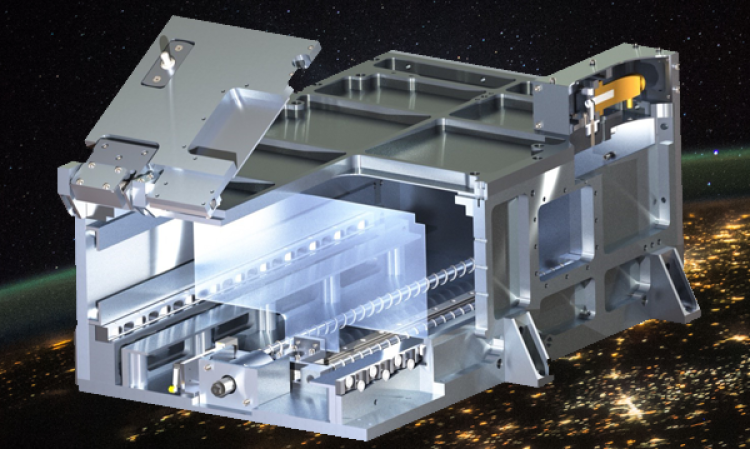
It’s hard to think of anything that could survive a fall off the Empire State Building while simultaneously being hit by a semi, but when you’re designing a device to handle the extremes of outer space, these requirements aren’t too far off. Surviving the wild temperature swings and earthshaking vibrations that go with being strapped onto one million pounds of explosives are just part of the process.
It says a lot about CU-Boulder that our mechanical engineering students are ready for the challenge.
In this case, undergraduate seniors Dane Ballou, Chip Bollendonk, Scott Lanning, Kevin Martin, and Nico Pinkowski worked with Lockheed Martin Space Systems to design a CubeSat Deployer prototype for NASA's Orion program. CubeSats are tiny satellites that are generally the size of a loaf of bread.
“We were given an awesome opportunity to work on a design that could potentially be used on actual deep-space missions in the 2020s if the quality of our work was good enough,” said Martin.
The project was part of the required capstone design course all mechanical engineering students take during their senior year. The program gives participants the opportunity to work with an outside business or research lab to solve a real-world engineering problem. Teams spend nine months designing, redesigning, building and rebuilding under the direction of senior design co-instructors Daria Kotys-Schwartz and Julie Steinbrenner.
Creating a machine to be used in space is a huge endeavor, and the team started testing their ideas by making simple models out of cardboard and rubber bands, according Steinbrenner.
“The best way to tackle big, complicated projects is to break it down into pieces that fit together. That’s the process engineers use in industry, and it’s what our students go through as well,” said Steinbrenner.
As the project moved forward, the team met regularly with Lockheed Martin engineers to keep things on track. Two big obstacles arose: money and the extreme vibrations of space launch.
They were able to overcome their financial problems with some outside help. The Sierra Nevada Corporation gave the team a huge discount on an ejector release mechanism, and Newcomb Spring donated a set of pricey custom-made springs, and then provided a second set when the team realized a miscommunication led them to order the wrong springs.
The vibrations were a bigger issue. The team had full specs on what the device would need to endure during launch, but along the way, learned their first design was not up to snuff.
“We did some preliminary force calculations (probably a little later than we should have) and realized we would need to apply almost 3,000 pounds of force to constrain the CubeSat with frictional forces, as we had originally intended. We had to go back to the drawing board and come up with a new confinement mechanism that would kinematically constrain the CubeSat in all six degrees of freedom," said Ballou.
Starting over on a critical component was an important learning experience. Senior design gives students a supportive environment where they can make mistakes and work through them. There are faculty members, peers, and professional engineers all available to fall back on for extra help. After the redesign, Ballou said the first successful test of the device was a great achievement.
“Watching the deployer actually release a CubeSat for the first time was pretty special,” said Ballou.
Pinkowski was even more enthusiastic.
"Having the door spring open was like my life's greatest achievement," said Pinkowski.
Pinkowski’s excitement underlines just how tough their project was to create. When a device is in space, it absolutely has to work. There are no second chances or space mechanics you can call up for repairs.
The device is now in Lockheed Martin's hands, and will probably go through a few additional prototype stages before it could make its way onto a future space mission. While that’s still years in the future, the team already received one big reward. They won first place in the annual mechanical engineering Senior Design Expo. Of course, space is still the ultimate goal.
“It was a great feeling to see us go from nothing to a fully designed and tested prototype for a system that’s going to MARS! MARS! How cool is that!?” said Pinkowski.
How many universities can say their students work on projects like that during their undergraduate years? In CU-Boulder mechanical engineering, it’s just another day in the classroom.
